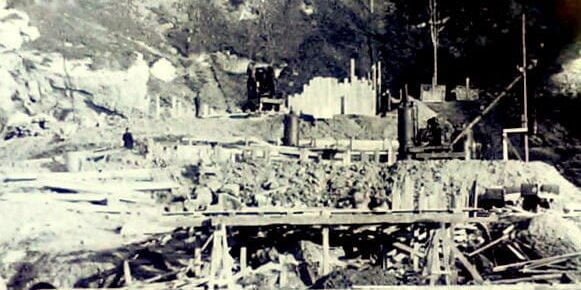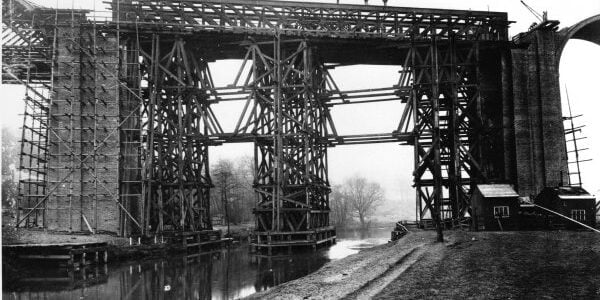Mexborough and Swinton Times February 17, 1906
The Big Viaduct at Conisbrough
A Huge Engineering Feat
By courtesy of Keith Butcher and Bygone Conisborough Denaby
http://keithsphotos.webs.com/
We present our readers this week with two interesting and unique photographs showing the great railway viaduct at Conisbrough in the making. In all probability we shall from time to time publish further photograph showing the progress of the work in connection with what is undoubtedly the greatest engineering undertaking witnessed in this district by the present generation, but in any event the photographs now published are of historical interest, or they show how the works stand at the present moment or how they will stand, at the most, for a week or two longer.

Just now the great chain of bridges which will span the Don Valley below Conisbrough Castle is beginning to take definite form; one can see the course the viaduct is to take, and gather an idea of what its appearance will be when completed. Every week that passes, so rapidly is the work being pushed forward, will alter the appearance of the construction – hence the value, historically, of the accompanying pictures, which show the great undertaking in embryo.
This magnificent engineering feat is the main feature of the new Dearne Valley Railway, an enterprise which is to connect the Lancashire and Yorkshire Railway from Crofton, near Wakefield, with the Great Northern and Great Eastern Railways at Black Carr, just below Balby.
It is the great and most distinctly engineering feature of the number four section of the new railway, the final portion of the line from Conisbrough Cliff to Cadeby, at a point locally known as “Coddy Holes,” and in the centre it will be 115 feet above the river Don. It is to consist of 21 arches, 14 in the Western or Cadeby bank of the river, and seven on the eastern or Conisbrough bank, which will be connected by an iron girder bridge spanning the historical river Don itself.
The contractors for this section of the new line are Messrs Henry Lovatt Ltd, of London and Manchester, and the work is being carried on under the supervision of Mr RH Clayton of Doncaster, the engineer of the Lancashire and Yorkshire Railway Company.
Mr W Kaye, of Leeds, is the designer of the viaduct, and Mr John Steele, at present of Conisbrough, is the clerk of the works in charge, on behalf of Messrs Lovatt, whose offices and works in connection with the undertaking or at Springwell, Doncaster.
Mr John Steel has had a wide previous experience of big engineer contracts, but regards the Conisbrough viaduct as the biggest thing he has yet seen in the way of railway bridge building. The new viaduct, it of course follows, will entirely alter the appearance of the Don Valley, but it does not follow it will destroy its picturesque character. It will be of symmetrical outline, and the grandeur of its proportions will rather lend to the impressiveness of the view than detract from it.
As a photograph you with show, considerable progress has been made with the work since they started, in March last year. At present some of the arches on the Cadeby side or up, and the stop piers of the other seven are well on the way. The centres of the first seven arches have been set, and three of the arches have actually being keyed in, while the foundations for the river appears both on the westerly side of the river, are being laid, and everything made ready for the erection of the piers which will have to carry the weight of the girder bridge that will span the river.
Each of the arches will ever span of 55 feet, varying in height from 40 feet at the eastern and western extremities to 115 feet in the centre. The girder bridge across the river will have a span of 150 feet. The total length of the viaduct will be 528 yards, or a quarter of a mile and 88 yards.
A feature of the works at Conisbrough is the overhead travelling cradle, used for carrying men and materials to and from across the river. This from one standard to another is more than half a mile long. It is technically called a ”Blondin” and is an American invention which was first used in England in connection with the erection of Vauxhall Bridge across the river Thames.
The viaduct is being built to carry a double line of rails, bitter present only a single track will be laid. This course is being adopted throughout the length of the line, the first section which has been completed and was passed by the Board of Trade Inspector and declared open last March. The viaduct arches are being built of red brick faced with a double course of Staffordshire pressd blue brick.
In all about 15 millions of brick will be employed in the construction, and a quantity of these are been supplied by local brick makers at Barnsley and Rotherham. The building of the viaduct is at present finding work for 250 men, but owing to the frost, progress at the time of writing as been checked. The work is expected to take another two years to complete in addition to the viaduct the engineering of the section involves a cutting 80 feet deep under the Doncaster road. With the completion of section 4, the whole of the line will be finished.
The Dearne Valley Railway, when completed, will provide the most direct road possible from Wexford to London and the south, forming an almost straight line from Crofton to Black Carr. It passes, as our readers are well aware, in our immediate district, through Goldthorpe, Bolton on Dearne, Barmborough, across Mexborough pastures, behind Denaby Main Colliery, and over the great Central Railway at Conisbrough to the viaduct, and on to Black Carr.
The popular impression that it will give railway access from the Goldthorpe, Bamburgh and Hickleton districts to Doncaster is not likely to be at present fulfilled, for it will be worked exclusively as a mineral line. No provision has be made for passenger stations and the probability is that the ultimate conveyance of passengers will have to wait until the development of the mineral traffic justifies extension in the shape of a double road. The powers for the construction of the Dearne Valley Railway were obtained by the Dearne Valley Railway Company, but as the line is completed it will be taken over and work by the Lancashire and Yorkshire railway stop that companies already working in the first section, which was completed and passed by the Board of Trade a year ago.







